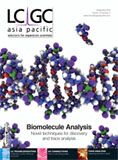High Speed Seperation of More Than 16 Polycyclic Aromatic Hydrocarbons
Knauer Application Note
S. Marten and A. Knöfel, Wissenschaftliche Gerätebau Dr. Ing. Herbert Knauer GmbH, Berlin, Germany
Introduction
Polyaromatic hydrocarbons (PAH) are particularly relevant in the analysis of environmental pollution because of their ubiquity, toxicity and persistence. Consequently, the PAHs have become the most intensively studied pollutants in environmental analysis.1,2 Standard and official methods for their analysis are available in guidelines for air, water, solid waste and food analysis.3 To attain the required selectivity of HPLC separations stationary phases specifically designed for PAH analysis are required.
Using standard HPLC for PAH analysis, injection-to-injection cycle times can often exceed 30 minutes. Under optimized conditions, gradient separations of the US EPA recommended standard test mixture of 16 PAH can be performed in about 15 minutes. The aim of this study was to investigate the resolution limit and analysis time for 16 PAH of the EPA standard plus 3 additional related aromatic compounds (1-methylnapthalene, triphenylene and p-terphenyl) using a PLATINblue system with a short BlueOrchid PAH column.
Experimental
The PAH analysis was developed on BlueOrchid PAH 50 × 2 mm column and a PLATINblue UHPLC high pressure gradient system. Please refer to Figure 1 for details.

Figure 1: Separation of 19 PAHs, overlay of five runs. Column: BlueOrchid PAH, 50 Ã 2 mm.
Results
After method optimization for the separation of the standard PAH mixture we spiked the mixture with 3 additional PAHs. To achieve a separation of these 19 PAHs in less than 2 min the method parameters were slightly modified (see Figure 1). In spite of the fast gradient applied (composition change rate of 2% per second), the reproducibility of the method was good with a maximum deviation of ΔtR = 0.012 min. In summary, we would recommend a flow-rate of 1 mL/min for an analysis time of 2.5 min, plus an equilibration time of 0.4 min run at a higher flow-rate of 1.5 mL/min. Side-effect: compared with the standard HPLC method the method above accounted for an eluent savings of 80% per analysis.
Conclusion
By using a shorter column with a smaller inner diameter and a KNAUER PLATINblue UHPLC system, complex mixtures such as the 19 PAHs can be analysed with excellent reproducibility and cycle times of less than 3 minutes. Optimizing the speed and resolution of routine analyses can not only save time but also dramatically decrease eluent costs, particularly important for analyses using acetonitrile.
References
1. M.N. Kayali-Sayadi et al., Fresenius J Anal Chem., 368(7), 697–701 (2000).
2. T. Wenzl et al., Trends in Analytical Chemistry, 25(7), 716–725 (2006).
3. AOAC 973.30; Deutsche DIN TVO; UK ISBN 0 11 752032 2; US EPS Methods TO-13, 550 550.1, 610, 8310 8330.

Wissenschaftliche Gerätebau Dr. Ing. Herbert Knauer GmbH
Hegauer Weg 38, 14163 Berlin, Germany
tel. +49 30 809727 0 fax +49 30 8015010
E-mail: info@knauer.net Website: www.knauer.net

A Novel LC–QTOF-MS DIA Method for Pesticide Quantification and Screening in Agricultural Waters
May 8th 2025Scientists from the University of Santiago de Compostela developed a liquid chromatography quadrupole time-of-flight mass spectrometry (LC–QTOF-MS) operated in data-independent acquisition (DIA) mode for pesticide quantification in agriculturally impacted waters.
Distinguishing Alcohol- from Non-Alcohol-Associated Liver Cirrhosis with LC-MS
May 7th 2025A pilot study investigating whether nicotinamide adenine dinucleotide kinase (NADK) expression is selectively diminished in alcohol-associated liver cirrhosis (AC), as well as evaluating its potential as a biomarker for this condition, measured AC and non-AC (NAC). Nicotinamide adenine dinucleotide (NAD+) and nicotinamide adenine dinucleotide phosphate (NADP+) levels in human liver samples were measured using liquid chromatography-mass spectrometry (LC-MS).
University of Oklahoma and UC Davis Researchers Probe Lipidomic Profiles with RP-LC–HRMS/MS
May 6th 2025A joint study between the University of Oklahoma Health Sciences Center (Oklahoma City, Oklahoma) and the UC Davis West Coast Metabolomics Center (Davis, California) identified differentially regulated lipids in type 2 diabetes (T2D) and obesity through the application of reversed-phase liquid chromatography-accurate mass tandem mass spectrometry (RP-LC-accurate MS/MS).

.png&w=3840&q=75)

.png&w=3840&q=75)



.png&w=3840&q=75)



.png&w=3840&q=75)












